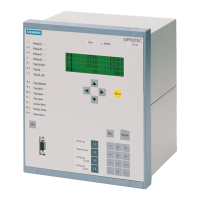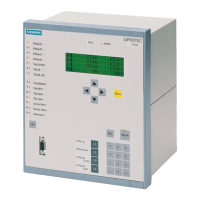Functions
2.19 Impedance Protection (ANSI 21)
SIPROTEC, 7UM62, Manual
C53000-G1176-C149-7, Release date 03.2010
159
Impedance Stages
The protection has the following characteristics which may be set independently:
1. Zone (fast tripping zone Z1 ) with parameters
ZONE Z1 Reactance = reach,
T-Z1 = 0 or short delay, if required.
Overreach zone Z1B, externally controlled via binary input, with parameters
ZONE Z1B Reactance = reach,
T-Z1B T1B = 0 or short delay, if required.
2. Zone (zone Z2) with parameters
ZONE Z2 Reactance = reach,
ZONE2 T2 The user must select a value for T2 above the grading time of the network
protection.
Non-directional final stage with parameter
T END The user must select T END so that the 2nd or 3rd stage of the series-con-
nected power system distance protection is overreached.
As the user may assume that impedance protection measurement extends into the unit transformer, parame-
trization must be selected to sufficiently consider the transformer control range.
Therefore ZONE Z1 is normally set to a reach of approx. 70 % of the protected zone (i.e. about 70 % of the
transformer reactance), with no or only a small delay (i.e. T-Z1 = 0.00 s to 0.50 s). Protection then switches off
faults on this distance after its operating time or with a slight time delay (high speed tripping). A time delay of
0.1 s is preferred.
For ZONE Z2 the reach could be set to about 100 % of the transformer reactance, or in addition to a network
impedance. The corresponding ZONE2 T2 time stage is to be set so that it overreaches the power system pro-
tective equipment of the following lines. The T END time is the last back-up time.
The following formula is generally valid for the primary impedance (with limiting to the unit transformer):
with
k
R
Protection zone reach [%]
u
SC
relative transformer short-circuit voltage [%]
S
N
Rated transformer power [MVA]
U
N
Machine-side rated transformer voltage [kV]
The derived primary impedances must be converted for the secondary side of the current and voltage trans-
formers. In general:
The nominal current of the protection device (= secondary nominal current of the current transformer) is auto-
matically considered by the device. You have already communicated the transformation ratios of the current
and voltage transformers to the device by entering the nominal transformer values (see section 2.5).

